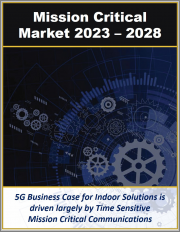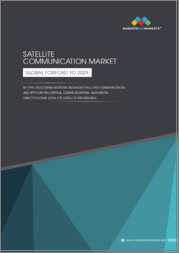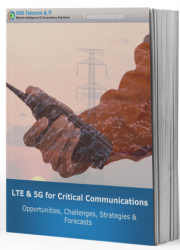
|
시장보고서
상품코드
1340145
세계의 미션 크리티컬 통신 시장(2023-2028년) : 기업, 산업, 정부 솔루션별Mission Critical Communications Market by Enterprise, Industrial and Government Solutions 2023 - 2028 |
||||||
미션 크리티컬 통신 시장은 급속히 발전하고 있으며, 음성, 데이터 및 머신 지향 통신을 개선하고자 하는 새로운 수요를 해결하는 데 필요한 솔루션이 개발 기술에 의해 제공되고 있습니다. 유틸리티, 항만, 운송과 같은 중요한 인프라를 관리하는 산업는 자산을 보호하고 업무를 최적화하기 위해 통신 강화가 필요합니다.
그 중 5G, AI, IoT 솔루션 등 기술이 중요한 역할을 한다고 생각되고 있습니다. 또한 네트워크와 시스템의 통합은 운영 관리에 부담을 주지 않고 이기종 솔루션을 통합할 수 있기 때문에 큰 기회를 보여줍니다.
미션 크리티컬 통신(Mission Critical Communications) 시장을 조사했으며, 공공 안전 개요/공공 안전을 위한 기술과 솔루션/5G, AI, IoT를 포함한 크리티컬 통신의 새로운 주요 기술 분야 분석/시장 규모 추이 예측/각종 구분·지역별 상세 분석/주요 기업 개요/주요 기업에 의한 사례 연구/각종 제안 등을 정리했습니다.
목차
제1장 주요 요약
제2장 소개
제3장 공공 안전 기술과 솔루션
- 공공 안전의 전망
- 공공안전에 대한 기대
- 공공 안전 목표
- 공공 안전 인프라
- 긴급시 대응·관리
- 응급 의료 서비스
- 화재·구조
- 법 집행
- 응답자 조정
- 공공 안전을 지원하는 최신 기술
- 공공 안전의 응답 포인트
- GIS
- Enhanced Wireless 9-1-1
- 실내 위치 정보 시스템
- 공공 안전 통신용 LMR
- 공공 안전 통신용 LTE
- 합법적 도청/CALEA
제4장 5G 기술 및 솔루션
- 5G 기기와 네트워크 운용
- LTE 기반, 디바이스 에코시스템, LAA, 5G에 대응 상황
- 스펙트럼 공유 및 이용
- 대규모 IoT용 좁은 밴드 5G
- 스몰셀 도입에 의한 멀티 커넥티비티 아키텍처
- 모바일 IoT 기술의 관련성 : NB-IoT·eMTC
- 5G 서비스 운영을 위한 OSS/BSS 아키텍처
- 멀티 안테나와 빔포밍의 영향
- 5G 네트워크 슬라이싱
- 포스트 5G 시대의 LTE 계속
- 서비스 디자인, ROI, 5G 네트워크
- 5G 기술과 네트워크에 미치는 영향
- 5G 기술과 네트워크 아키텍처
- 5G 네트워크 도입
- LTE Advanced, LTE Pro, 그 이후를 지원하는 솔루션
제5장 AI 기술 및 생태계 분석
- AI 기술 매트릭스
- 머신러닝
- 자연언어처리
- 컴퓨터 비전
- 음성인식
- 컨텍스트 어웨어 처리
- 인공신경망
- 예측 API
- 자율형 로보틱스
- AI 기술의 준비 상황
- 머신러닝 API
- AI 기술의 목표
- AI 툴과 접근
- 감정 검출에 있어서 AI
- IoT 용도 및 빅 데이터 애널리틱스
- 데이터 과학 및 예측 분석
- 엣지 컴퓨팅과 5G 네트워크
- 클라우드 컴퓨팅 및 머신러닝
- 스마트 머신과 가상 트위닝
- 공장 자동화 및 인더스트리 4.0
- 빌딩 오토메이션과 스마트 워크플레이스
- 클라우드 로봇과 공공 안전
- SDN과 도메인별 네트워크
- 예측 3D 디자인
제6장 IoT 기술 및 밸류체인 분석
- IoT 반도체 빌딩 블록
- 무선 센서
- IoT 프로세서
- 게이트웨이
- 애플리케이션
- IoT 칩셋
- 네트워크 기술과 프로토콜
- 실시간 OS
- 오픈소스 RTOS
- 상용 RTOS
- 분산 스트림 컴퓨팅 플랫폼
- IoT 소프트웨어 및 플랫폼
- IoT 애널리틱스
- IoT 보안
- IoT 디바이스 관리
- IoT 표준과 API의 상호 운용성
- IoT 산업의 용도
- 밸류체인 분석
- IoT 투자와 시장 제휴
- 모바일 네트워크 사업자의 역할
- IoT와 차세대 공공안전
제7장 공공 안전 및 기업용 크리티컬 통신
- 도입 상태
- 3GPP 정의의 중요한 통신
- 미션 크리티컬 PTT
- 미션 크리티컬 PTT, 비디오, 데이터
- 공중 안전을 위한 격리된 LTE 운영
- 고전력 사용자 장비
- IoT에 의한 공공 안전의 향상
- URLLC
- 5G와 WiFi Version 6의 비교
제8장 크리티컬 통신 시장의 분석 및 예측
- 세계의 크리티컬 통신 시장
- 크리티컬 통신 매니지드 서비스 시장
- 치명타 통신 시장 : 부문별
- 치명타 통신 시장 : 공공 안전 산업별
- 공공 안전에 있어서 AI에 의한 IoT 크리티컬 통신 시장
- 치명타 통신 시장 : 지역별
- 지역의 크리티컬 통신 시장
- 아시아 태평양
- 북미
- 유럽
- 남미
- 중동 및 아프리카
제9장 미션 크리티컬 기업 분석
- AGT International
- Atos SE
- Cisco Systems
- Dataminr
- Enforsys
- ESRI
- General Dynamics Corporation
- L3Harris Technologies
- Hexagon
- Hitachi Vantara
- Honeywell International
- Huawei Technologies
- IBM
- Ericsson
- Motorola Solutions
- NEC Corporation
- Nice Systems
- Nokia Corporation
- Northrop Grumman Corporation
- RapidSOS
- SAP SE
- SAS
- Sonim Technologies
- Tyler Technologies
- FirstNet
- Verizon
- AT&T
- Red Box Recorders Ltd.
- iNet Public Safety
- 코단 커뮤니케이션
- Intellitech Corporation
- Parallel Wireless
- Twilio
- Intersec
- Bandwidth
- Intrado
- Comtech
제10장 미션 크리티컬 기업의 사례 연구
- AT&T
- Motorola Solutions
- Nokia
- L3Harris
- Ericsson
- ZTE
- Huawei Technologies
- Hytera
- Ascom
- Cobham Wireless
제11장 중요한 통신 사례 연구
- 공공 안전 용도 및 서비스의 최신화
- 5G 커넥티드 구급차
- 지능형, 멀티서비스, 울트라 브로드밴드 네트워크 아키텍처
- 커넥티드 드론에 의한 쓰나미에 대비
- 긴급 통신 플랫폼
제12장 총론·제안
- 공공 안전 부문
- 기업 및 산업 부문
제13장 부록 : 산업 분야에서 크리티컬 통신 인프라·LTE·5G
LYJ 23.09.11Overview:
The market for mission critical communications is rapidly evolving as developing technologies supply solutions necessary to meet emerging demand for improved voice, data, and machine-oriented communications. Industry verticals that manage critical infrastructure (such as utilities, ports, and transportation) also require enhanced communications to safeguard assets and optimize operations.
We see a few technologies playing a key role including 5G, Artificial Intelligence, and Internet of Things (IoT) solutions. In addition, there is a strong opportunity for network and system integration as otherwise disparate solutions converge in a manner in which operations management does not become onerous.
This report evaluates core public safety technology and solutions as well as emerging key areas for critical communications including 5G, AI, and IoT. This report also assesses emerging areas for mission critical communications including ultra-reliable low-latency communications for enterprise, industrial, and government sectors.
Companies in Report:
|
|
Table of Contents
1. Executive Summary
2. Introduction
3. Public Safety Technologies and Solutions
- 3.1. Public Safety in Perspective
- 3.2. Public Safety Expectations
- 3.2.1. Real-Time Access to Information
- 3.2.2. Anytime, Anywhere Connectivity
- 3.2.3. Increased Situational Awareness
- 3.3. Public Safety Objectives
- 3.3.1. Prevention
- 3.3.2. Detection
- 3.3.3. Mitigation
- 3.3.4. Investigation
- 3.4. Public Safety Infrastructure
- 3.4.1. Critical Control Systems
- 3.4.2. Critical Communication Networks
- 3.4.3. Surveillance and Identification
- 3.4.4. Emergency Disaster Management
- 3.5. Emergency Response and Control
- 3.5.1. Emergency Medical Services
- 3.5.2. Fire/Rescue
- 3.5.3. Law Enforcement
- 3.5.4. Responder Coordination
- 3.6. Current Technologies Supporting Public Safety
- 3.6.1. Public Safety Answer Points
- 3.6.2. Geographic Information Systems
- 3.6.3. Enhanced Wireless 9-1-1
- 3.6.4. Indoor Location Systems
- 3.6.5. LMR for Public Safety Communications
- 3.6.6. LTE for Public Safety Communications
- 3.6.7. Lawful Intercept/CALEA
4. 5G Technology and Solutions
- 4.1. 5G Equipment and Network Operation
- 4.1.1. LTE Foundation, Device Ecosystem, LAA, and 5G Readiness
- 4.1.2. Spectrum Sharing and Utilization
- 4.1.3. Narrowband 5G for Massive IoT
- 4.1.4. Multi Connectivity Architecture with Small Cell Deployment
- 4.1.5. Relevance of Mobile IoT Technology: NB-IoT and eMTC
- 4.1.6. OSS/BSS Architecture for 5G Service Operation
- 4.1.7. Multi-Antenna and Beamforming Impact
- 4.1.8. 5G Network Slicing
- 4.1.9. Continuation of LTE in Post-5G Era
- 4.1.10. Service Design, ROI and 5G Network
- 4.2. 5G Technology and Network Impacts
- 4.2.1. Network Coverage and Efficiency
- 4.2.2. Network Spectrum Efficiency
- 4.2.3. Data Throughput
- 4.2.4. Connection Density
- 4.2.5. Ultra-Reliable Low Latency Communication
- 4.2.6. Network Energy Usage
- 4.2.7. Improved Battery Life
- 4.2.8. Improved Flexibility in Air Interface and Versatility
- 4.2.9. Massive MIMO
- 4.2.10. mmWave Technology
- 4.2.11. Integration of Access and Backhaul
- 4.2.12. D2D Communication
- 4.2.13. Flexible Duplex: FDD and TDD
- 4.2.14. Multi-Antenna Transmission Scenario
- 4.2.15. Decoupling User Data from Control System
- 4.3. 5G Technology and Network Architecture
- 4.3.1. Massive MIMO and Beamforming
- 4.3.2. Cloud RAN
- 4.3.3. Broadband Spectrum and Satellite
- 4.3.4. 5G New Radio
- 4.3.5. Software Defined Air Interface
- 4.3.6. Network Function Virtualization
- 4.3.7. Self Organizing Network and Self Healing Network
- 4.3.8. HetNet and H-CRAN
- 4.3.9. Large-Scale Cooperative Spatial Signal Processing
- 4.3.10. Software Defined Radio
- 4.3.11. Visible Light Communications
- 4.3.12. Cross-Layer Controller
- 4.3.13. Cognitive Radios and Transmission Technologies
- 4.3.14. Scalable OFDM and Subcarrier Spacing
- 4.4. 5G Network Implementation
- 4.4.1. Base Stations
- 4.4.2. Small Cells
- 4.4.3. Macro Cells
- 4.4.4. Baseband Units and RF Units
- 4.4.5. Mobile Core
- 4.4.6. Remote Radio Heads
- 4.4.7. Front-haul and Backhaul Networks
- 4.5. LTE Advanced, LTE Pro, and Beyond Supported Solutions
- 4.5.1. Mobile IoT and M2M Communication
- 4.5.2. Broadcast Services and Immersive Entertainment
- 4.5.3. Vehicular Communication
- 4.5.4. Public Safety Network
- 4.5.5. Smart City Applications
- 4.5.6. Private Enterprise Network
5. AI Technology and Ecosystem Analysis
- 5.1. AI Technology Matrix
- 5.1.1. Machine Learning
- 5.1.1.1. Deep Learning
- 5.1.1.2. Supervised vs. Unsupervised Learning
- 5.1.1.3. Reinforcement Learning
- 5.1.2. Natural Language Processing
- 5.1.3. Computer Vision
- 5.1.4. Speech Recognition
- 5.1.5. Context Aware Processing
- 5.1.6. Artificial Neural Network
- 5.1.7. Predictive APIs
- 5.1.8. Autonomous Robotics
- 5.1.1. Machine Learning
- 5.2. AI Technology Readiness
- 5.3. Machine Learning APIs
- 5.3.1. IBM Watson API
- 5.3.2. Microsoft Azure Machine Learning API
- 5.3.3. Google Prediction API
- 5.3.4. Amazon Machine Learning API
- 5.3.5. BigML
- 5.3.6. AT&T Speech API
- 5.3.7. Wit.ai
- 5.3.8. AlchemyAPI
- 5.3.9. Diffbot
- 5.3.10. PredictionIO
- 5.3.11. General Application Environment
- 5.4. AI Technology Goals
- 5.5. AI Tools and Approaches
- 5.6. AI in Emotion Detection
- 5.6.1. Facial Detection APIs
- 5.6.2. Text Recognition APIs
- 5.6.3. Speech Recognition APIs
- 5.7. IoT Application and Big Data Analytics
- 5.8. Data Science and Predictive Analytics
- 5.9. Edge Computing and 5G Network
- 5.10. Cloud Computing and Machine Learning
- 5.11. Smart Machine and Virtual Twinning
- 5.12. Factory Automation and Industry 4.0
- 5.13. Building Automation and Smart Workplace
- 5.14. Cloud Robotics and Public Security
- 5.15. Self Driven Network and Domain-Specific Network
- 5.16. Predictive 3D Design
6. IoT Technology and Value Chain Analysis
- 6.1. IoT Semiconductor Building Blocks
- 6.1.1. Wireless Sensors
- 6.1.2. IoT Processors
- 6.1.3. Gateways
- 6.1.4. Applications
- 6.2. IoT Chipsets
- 6.3. Network Technology and Protocols
- 6.4. Real-Time Operating System
- 6.4.1. Open Source RTOS
- 6.4.2. Commercial RTOS
- 6.4.3. Distributed Stream Computing Platforms
- 6.5. IoT Software and Platforms
- 6.5.1. IoT Analytics
- 6.5.2. IoT Security
- 6.5.3. IoT Device Management
- 6.5.4. IoT Standard and API Interoperability
- 6.6. IoT Industry Applications
- 6.7. Value Chain Analysis
- 6.7.1. IoT Hardware Device Provider
- 6.7.2. IoT Component Provider
- 6.7.3. IoT Platform Provider
- 6.7.4. IoT Software and Service Provider
- 6.8. IoT Investment and Market Alliances
- 6.9. Role of Mobile Network Operators
- 6.10. IoT and Next Generation Public Safety
- 6.10.1. IoT and Public Safety Opportunity Areas
- 6.10.2. Integrating IoT with Public Safety Communications
- 6.10.3. Integrating IoT and Direction Communications
7. Critical Communication for Public Safety and Enterprises
- 7.1. Deployment Status
- 7.2. 3GPP-Defined Critical Communications
- 7.2.1. Mission Critical Push to Talk
- 7.2.2. Mission-Critical PTT, Video & Data
- 7.2.3. Isolated LTE Operation for Public Safety
- 7.2.4. High Power User Equipment
- 7.3. IoT to Improve Public Safety
- 7.4. Ultra-Reliable Low Latency Communications or URLLC
- 7.5. Comparison of 5G with WiFi Version 6
8. Critical Communication Market Analysis and Forecasts
- 8.1. Global Critical Communication Market 2023-2028
- 8.1.1. Critical Communications Managed Service Market
- 8.1.2. Critical Communication Market by Segment
- 8.1.2.1. Critical Communication Market by IoT Critical Infrastructure
- 8.1.2.2. Critical Communication Market by Public Safety Communication Technology
- 8.1.2.2.1. Critical Communication Market by Licensed LMR Standard
- 8.1.2.2.2. Critical Communication Market by DMR Standard
- 8.1.2.2.3. Critical Communication Market by Licensed LMR Type
- 8.1.2.2.4. Critical Communication Market by Commercial LMRs Frequency
- 8.1.2.2.5. Critical Communication Market by Public Safety LTE Standard
- 8.1.2.2.6. Critical Communication Market by Public Safety LTE Type
- 8.1.2.3. Critical Communication Market by Professional Service
- 8.1.3. Critical Communication Market by Public Safety Industry Vertical
- 8.1.3.1. Critical Communication Market by Military Application
- 8.1.3.2. Critical Communication Market by Public Transportation Application
- 8.1.3.3. Critical Communication Market by Utilities and Smart Grid Application
- 8.1.4. AI Powered IoT Critical Communication Market in Public Safety
- 8.1.4.1. AI Powered IoT Critical Communication Market by Segment
- 8.1.4.2. AI Powered IoT Critical Communication Market by AI Technology
- 8.2. Regional Critical Communication Market 2023-2028
- 8.2.1. Critical Communication Market by Region
- 8.2.2. APAC Critical Communication Market by IoT Critical Infrastructure, Public Safety Communication, Professional Service, AI Technology, and Country
- 8.2.3. North America Critical Communication Market by IoT Critical Infrastructure, Public Safety Communication, Professional Service, AI Technology, and Country
- 8.2.4. Europe Critical Communication Market by IoT Critical Infrastructure, Public Safety Communication, Professional Service, AI Technology, and Country
- 8.2.5. Latin America Critical Communication Market by IoT Critical Infrastructure, Public Safety Communication, Professional Service, AI Technology, and Country
- 8.2.6. Middle East and Africa Critical Communication Market by IoT Critical Infrastructure, Public Safety Communication, Professional Service, AI Technology, and Country
9. Mission Critical Company Analysis
- 9.1. AGT International
- 9.2. Atos SE
- 9.3. Cisco Systems
- 9.4. Dataminr
- 9.5. Enforsys
- 9.6. ESRI
- 9.7. General Dynamics Corporation
- 9.8. L3Harris Technologies
- 9.9. Hexagon
- 9.10. Hitachi Vantara
- 9.11. Honeywell International
- 9.12. Huawei Technologies
- 9.13. IBM
- 9.14. Ericsson
- 9.15. Motorola Solutions
- 9.16. NEC Corporation
- 9.17. Nice Systems
- 9.18. Nokia Corporation
- 9.19. Northrop Grumman Corporation
- 9.20. RapidSOS
- 9.21. SAP SE
- 9.22. SAS
- 9.23. Sonim Technologies
- 9.24. Tyler Technologies
- 9.25. FirstNet
- 9.26. Verizon
- 9.27. AT&T
- 9.28. Red Box Recorders Ltd.
- 9.29. iNet Public Safety
- 9.30. Codan Communications
- 9.31. Intellitech Corporation
- 9.32. Parallel Wireless
- 9.33. Twilio
- 9.34. Intersec
- 9.35. Bandwidth
- 9.36. Intrado
- 9.37. Comtech
10. Mission Critical Company Case Studies
- 10.1. AT&T
- 10.1.1. Company Background
- 10.1.2. Product Portfolio
- 10.1.3. Recent Developments
- 10.2. Motorola Solutions
- 10.2.1. Company Background
- 10.2.2. Product Portfolio
- 10.2.3. Recent Developments
- 10.3. Nokia
- 10.3.1. Company Background
- 10.3.2. Product Portfolio
- 10.3.3. Recent Developments
- 10.4. L3Harris
- 10.4.1. Company Background
- 10.4.2. Product Portfolio
- 10.4.3. Recent Developments
- 10.5. Ericsson
- 10.5.1. Company Background
- 10.5.2. Product Portfolio
- 10.5.3. Recent Developments
- 10.6. ZTE
- 10.6.1. Company Background
- 10.6.2. Product Portfolio
- 10.6.3. Recent Developments
- 10.7. Huawei Technologies
- 10.7.1. Company Background
- 10.7.2. Product Portfolio
- 10.7.3. Recent Developments
- 10.8. Hytera
- 10.8.1. Company Background
- 10.8.2. Product Portfolio
- 10.8.3. Recent Developments
- 10.9. Ascom
- 10.9.1. Company Background
- 10.9.2. Product Portfolio
- 10.9.3. Recent Developments
- 10.10. Cobham Wireless
- 10.10.1. Company Background
- 10.10.2. Product Portfolio
- 10.10.3. Recent Developments
11. Critical Communication Case Studies
- 11.1. Modernizing Public Safety Applications and Services
- 11.2. 5G Connected Ambulances
- 11.3. Intelligent, Multiservice, and Ultra-Broadband Network Architecture
- 11.4. Tsunami Preparedness with Connected Drones
- 11.5. Emergency Communications Platforms
12. Conclusions and Recommendations
- 12.1. Public Safety Sector
- 12.2. Enterprise and Industrial Sectors
13. Appendix: Critical Communications Infrastructure, LTE and 5G in Industrial Verticals
- 13.1. Mission Critical Communications Infrastructure Market
- 13.1.1. Mission Critical Communications by Equipment, Software, and Service
- 13.1.2. Mission Critical Communications Infrastructure by Platform Type
- 13.2. LTE and 5G Critical Communications Market
- 13.2.1. Critical Communication Applications 2023-2028
- 13.2.2. Critical Communications by Major Market Segment 2023-2028
- 13.3. 5G New Radio in Industrial Critical Communications
- 13.3.1. 5GNR Applications in Industrial Automation 2023-2028
- 13.3.2. 5GNR Applications by Deployment Type 2023-2028
- 13.3.3. Industrial Automation Market in Private 5GNR 2023-2028
- 13.3.4. Private 5GNR in Industrial Automation by Application 2023-2028
- 13.4. 5G Ultra-reliable Low Latency Communications Critical Communications
- 13.5. North America
- 13.6. Europe
- 13.7. Asia Pacific
- 13.8. Latin America
- 13.9. Middle East and Africa



















